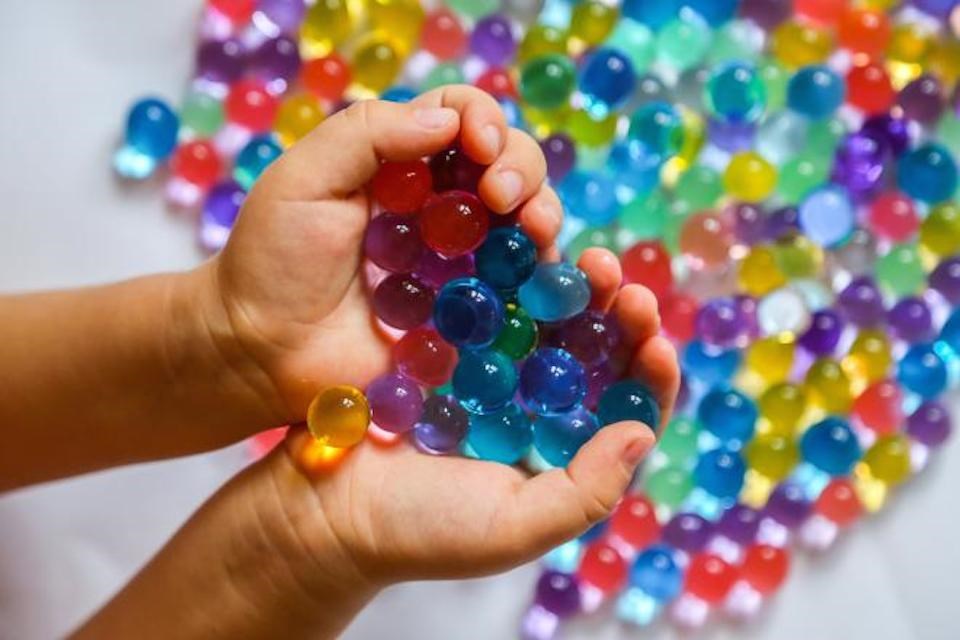NEWS RELEASE
HEALTH CANADA
*****************************
Product: Water beads
Issue:
Consumer products - Aspiration hazard
Consumer products - Choking hazard
Consumer products - Injury hazard
What to do
Water beads and products containing them should be kept out of sight and reach of children; if you suspect that your child has ingested a water bead, call the Canadian Poison Centre hotline at 1-844-POISON-X (Quebec residents call 1-800-463-5060 to reach the Centre antipoison du Quebec).
Affected products
Water beads
Issue
Health Canada is warning parents and caregivers about the risks of water beads. These tiny beads, also known as jelly beads, hydro orbs, crystal soil, sensory beads or orb beads, are water-absorbing gel beads that can grow up to 1,500 times their size when placed in water. Water beads can be very harmful if swallowed or put in the ears or nose. If ingested, water beads can continue to grow inside the body leading to potentially life-threatening injuries, such as intestinal or bowel obstruction.
Water beads can be found in a wide range of products that may be accessible to children, such as toys, art kits, stress balls, foot baths, vase fillers, and gardening products. They are also sold in their dehydrated form in individual containers. They may be promoted to parents and caregivers of young children, specifically for use in sensory bins.
Water beads are typically brightly coloured. This may lead young children or adults with cognitive impairment to mistake them for candy. These beads are also small, slippery, and bouncy, allowing them to roll away from their initial location. In several incidents, children gained access to beads that had rolled to another area of the home and were overlooked during clean-up. In some reported cases, the beads had been purchased for, and used by, an older sibling, but a younger child was able to gain access to them. In other reported cases, young children gained access to water beads while at school or in childcare.
Health Canada is aware of several international incidents where children who had ingested water beads sustained life-threatening injuries requiring surgical intervention. In the United States, there have been at least 248 known water bead cases as reported to the National Electronic Injury Surveillance System (NEISS) from Jan. 1, 2017 to Nov. 22, 2022. Of the 248 NEISS incident reports related to water beads: 112 were involved in ingestion, 100 involved ear canal insertion, 35 involved nasal cavity insertion and 1 involved eye injury. From June 20, 2011, to Jan. 31, 2023, Health Canada’s Consumer Product Safety Program received six reports related to water beads. Three of the reports involved an injury, one of which was severe.
What parents and caregivers should do
If you suspect that your child has ingested a water bead, call the Canadian Poison Centre hot line at 1-844-POISON-X (Quebec residents call 1-800-463-5060 to reach the Centre antipoison du Quebec).
- Monitor for symptoms, such as:
- vomiting
- abdominal or chest pain
- abdominal swelling or soreness
- constipation
- lethargy
- drooling
- difficulty breathing or swallowing
- loss of appetite
- If water beads are placed in the nose or ear, seek medical intervention.
- Water beads should always be stored in an airtight container out of sight and reach of children, especially those under the age of five.
- It is recommended that caregivers of children under five avoid having water beads in their household or classroom, even if intended for an older child or adult use.
- If using water beads with children five and up, closely supervise their play.
- After using water beads, thoroughly clean the surrounding area and clean up any beads that may have rolled away. Check under furniture, toys and in adjoining rooms for water beads that may have rolled away from their initial location.
What health care professionals should do
Patients who have non-specific symptoms such as vomiting, abdominal or chest pain, abdominal swelling or soreness, constipation, lethargy, drooling, difficulty breathing or swallowing or loss of appetite may have swallowed a water bead. It is important to investigate this possibility immediately as water beads are unlikely to show up on an X-ray.
Health Canada encourages health care professionals to report any water bead-related injuries through our incident reporting form. https://health.canada.ca/en/health-canada/services/consumer-product-safety/advisories-warnings-recalls/report-incident-involving-consumer-product-b.html#1 Reporting provides valuable information to help act on the safety of products.
What Health Canada is doing
Health Canada is committed to helping protect people living in Canada from potentially dangerous consumer products. The Department is continuing its examination of the risks associated with water beads specifically to help protect young children. Health Canada regularly monitors consumer products on the Canadian market and will continue to investigate reports related to water beads to help keep consumers safe. The Department will also take enforcement actions at any time if there is reason to believe a consumer product poses a danger to human health or safety.
*****************************



